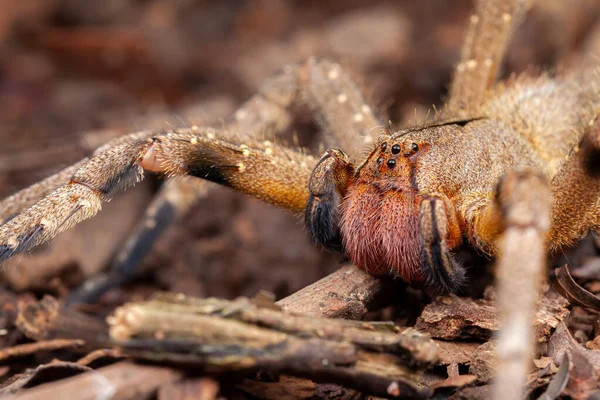What to know about “Brazilian wandering spiders” As a health researcher, I’m drawn to creatures with both captivating beauty and potential danger. The Brazilian wandering spider, also known as the armed spider or banana spider (due to their occasional presence in fruit shipments), is a prime example. Let’s delve into the fascinating world of these spiders, understanding their bites, the effects on humans, and how to stay safe.

A Potent Venom: What Happens if You Get Bitten?
The Brazilian wandering spider belongs to the genus Phoneutria, a name meaning “murderess” in Greek. This moniker reflects the potency of their venom, which is primarily neurotoxic. This means it disrupts communication between nerves and muscles.
While bites are thankfully rare, understanding the potential effects is crucial. Here’s a breakdown of what you might experience:
- Immediate Local Pain: The bite itself is intensely painful, often described as a burning or searing sensation.
- Autonomic Symptoms: These include sweating, nausea, vomiting, increased heart rate and blood pressure, and muscle cramps.
- Priapism: A hallmark symptom, particularly in men, is a prolonged and often painful erection lasting for several hours. A 2023 study published in the journal “Nature” explored the potential of a venom component, Tx2-6, for treating erectile dysfunction in cases where conventional medications fail [1].
- Central Nervous System Effects: In severe cases, respiratory paralysis and coma can occur.
The good news is that fatalities due to Brazilian wandering spider bites are uncommon, especially with prompt medical attention. A study published by the Institute of Butantan in São Paulo, Brazil, found that with proper antivenom administration, the mortality rate dropped significantly [2].
What to Do After a Spider Bite: Seeking Medical Attention
After experiencing a spider bite, it is crucial to understand when seeking medical attention is necessary to ensure proper care and treatment. While most spider bites are harmless and can be managed at home, certain circumstances warrant immediate medical evaluation. Here is a detailed guide on when to seek medical attention after a spider bite:
- Identifying Severe Symptoms: If you experience severe symptoms after a spider bite, such as sharp pain, swelling, sweating, severe stomach cramps, fever, chills, joint pain, weakness, nausea, headache, or the development of a deep ulcer at the bite site, it is essential to seek medical attention promptly. These symptoms can indicate a more serious reaction to the spider bite, especially if caused by venomous spiders like black widows or brown recluses.
- Allergic Reactions: Individuals who suspect they are allergic to spider venom or exhibit signs of an allergic reaction, such as trouble breathing, loss of consciousness, severe swelling or itchiness at the bite site, fast heart rate, or swelling in the mouth or face, should seek immediate medical care. Anaphylaxis, a severe allergic reaction, requires urgent treatment to prevent complications.
- Worsening Symptoms: If the symptoms of a spider bite worsen over time, including the appearance of fever, pain near the bite site after 1 to 2 days, an enlarged wound site, red streaking from the bite, muscle cramps, blistering, or flu-like symptoms, it is advisable to consult a healthcare provider. Worsening symptoms may indicate a venomous spider bite or an infection that requires medical attention.
- Multiple Bites or Unexplained Symptoms: If you have multiple bites on different parts of your body or if several individuals in your household have been bitten, and there is uncertainty about the cause of the symptoms, it is essential to consult a doctor. In such cases, a thorough examination is necessary to rule out other potential causes, such as infection or vasculitis.
- Follow-up Care: After seeking medical attention for a spider bite, it is crucial to follow up with healthcare providers as recommended. This ensures proper monitoring of the bite site, evaluation of symptoms, and any necessary treatment adjustments. Adhering to follow-up care instructions is vital for optimal recovery and management of spider bites.
Understanding the signs that indicate the need for medical attention after a spider bite is essential for timely and appropriate care. By recognizing severe symptoms, allergic reactions, worsening conditions, and the importance of follow-up care, individuals can ensure their well-being and receive the necessary treatment for spider bites.
Why Are Brazilian Wandering Spiders So Aggressive?
Brazilian Wandering Spiders, scientifically known as Phoneutria, exhibit remarkable aggression due to various factors deeply rooted in their biology and behavior. These spiders are renowned for their aggressive nature, which sets them apart from many other spider species. Here are the key reasons behind the aggressive behavior of Brazilian Wandering Spiders:

- Territorial Behavior: Brazilian Wandering Spiders are territorial creatures, often engaging in fights over territory when there are too many individuals in one area. This territorial instinct drives them to be aggressive towards other spiders, ensuring they can establish and defend their space effectively [3].
- Mating Competition: During the mating season, male Brazilian Wandering Spiders become highly aggressive towards each other as they compete for the opportunity to mate with a female. This intense competition drives them to exhibit aggressive behaviors, including fighting to secure mating rights.
- Defense Mechanism: When threatened, Brazilian Wandering Spiders adopt an “attack first, ask questions later” defense strategy. This defensive stance, combined with their aggressive nature, allows them to stand their ground and appear menacing when confronted, making them formidable in defending themselves against potential threats.
- Stress in Captivity: Branozilian Wandering Spiders do not fare well in captivity due to the stress it causes them. The stress of captivity can lead to behavioral changes, including decreased feeding and increased aggression. This stress-induced aggression further highlights the complex nature of these spiders and their response to environmental stimuli.
- Natural Instincts: The aggressive tendencies of Brazilian Wandering Spiders are deeply ingrained in their biology and evolutionary history. These spiders have evolved to survive in challenging environments, where aggression plays a crucial role in securing resources, defending against predators, and ensuring reproductive success.
The aggressive behavior of Brazilian Wandering Spiders is a multifaceted trait influenced by territorial instincts, mating competition, defense mechanisms, captivity stress, and natural evolutionary adaptations. These factors collectively contribute to the unique and formidable nature of these spiders, making them a fascinating subject of study in the realm of arachnology.
Beyond the Bite: Other Interesting Facts about Brazilian Wandering Spiders
These spiders are not all venom and aggression. Here are some captivating aspects of their biology:
- Size Matters: Brazilian wandering spiders are some of the largest spiders in the world. Their leg span can reach up to 6 inches (15 cm), with a body size comparable to a ping pong ball!
- Mating Rituals: The male spider performs a fascinating courtship dance to attract females. He vibrates his abdomen while holding a wrapped insect gift, a peace offering to the potential mate.
- Silk Spinning Savvy: While they don’t build elaborate webs, they do use silk for constructing egg sacs and lining their burrows.
- Natural Enemies: Despite their potency, these spiders have predators. Certain wasp species and primates have been documented preying on them.
Living Alongside Brazilian Wandering Spiders: Safety Tips
While these spiders can be intimidating, encounters with humans are rare. Here are some tips to minimize the risk of bites:
- Be Aware of Their Habitat: If you live in or are visiting areas where these spiders are found, be aware of their potential presence, especially in dark, cluttered spaces like woodpiles or under rocks.
- Wear Protective Clothing: Long pants, closed-toe shoes, and gloves can offer some protection when venturing into areas where these spiders might be present.
- Shake Out Clothing and Shoes: Before putting on clothes or shoes that have been stored outdoors, give them a good shake to dislodge any potential spider hitchhikers.
- Secure Your Home: Seal cracks and gaps around doors and windows to prevent wandering spiders from entering your home.
FAQs: Addressing Your Questions
Are Brazilian wandering spiders the most venomous spiders in the world?
The title of “most venomous” can be debated depending on how venom potency is measured. While Brazilian wandering spiders are certainly high contenders, the Sydney funnel-web spider (Atrax robustus) is currently considered the record holder according to Guinness World Records.
Should I be afraid of Brazilian wandering spiders?
A healthy dose of respect is wise, but fear is not necessary. Encounters with humans are uncommon, and these spiders are not inherently aggressive. Following the safety tips mentioned earlier can further minimize risks.
What if I find a Brazilian wandering spider in my home?
If you encounter one indoors, the safest approach is to call a professional pest control service. They have the expertise and equipment to handle the situation safely.
Remember: By understanding and respecting these remarkable spiders, we can ensure a safe and harmonious coexistence.
Conclusion: Respectful Coexistence
The Brazilian wandering spider is a fascinating creature, a force of nature with both beauty and potential danger. By understanding their biology and behavior, we can learn to coexist with them respectfully. While their venom is potent, bites are rare, and with proper medical attention, the risks are significantly reduced.
Let’s appreciate these spiders for their ecological role and the potential scientific insights they offer, while prioritizing safety measures to minimize the risk of encounters.









